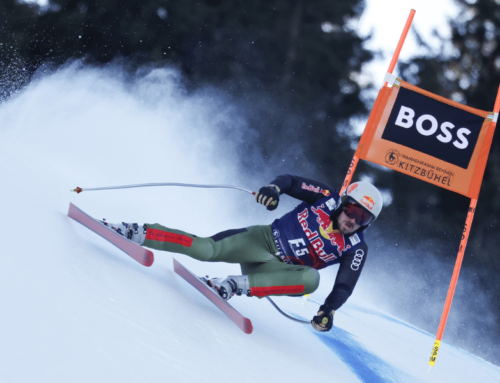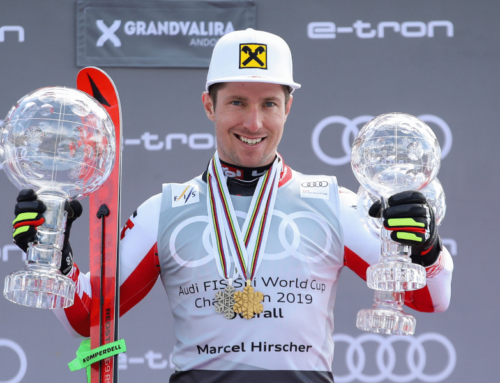World Cup Rewind: Weather presents challenges
An outdoor mountain sport in winter has it's own unique disadvantages. The opening weekend of the all-too brief North American swing of the alpine World Cup, Nov. 29 and 30, displayed one of the primary among those disadvantages: bad weather.
The men raced at Lake Louise, Alberta and held one race with three distinctly different atmospheric conditions. The women raced at Aspen, Colo., where swirling winds tore down the Audi sponsor banner from over the finish line. … during the race.
An outdoor mountain sport in winter has it's own unique disadvantages. The opening weekend of the all-too brief North American swing of the alpine World Cup, Nov. 29 and 30, displayed one of the primary among those disadvantages: bad weather.
 The men raced at Lake Louise, Alberta and held one race with three distinctly different atmospheric conditions. The women raced at Aspen, Colo., where swirling winds tore the down the Audi sponsor banner from over the finish line. … during the race.
The men raced at Lake Louise, Alberta and held one race with three distinctly different atmospheric conditions. The women raced at Aspen, Colo., where swirling winds tore the down the Audi sponsor banner from over the finish line. … during the race.
For the most part the athletes took it all in stride. After all, they're used to it.
"We train in this all the time," says Julia Mancuso. "We live in the winter. We live for snow. You take what you get."
They got plenty.
In Lake Louise the top three of the opening downhill included the first men's downhill podium ever for Sweden from Hans Olsson, a first time winner in Italian Peter Fill, and most remarkable, a second place finish from the 65th start for 22 year old Swiss Carlo Janka. They all earned their placings with some fine skiing, but weather shifted from perfect to bad to horrible and then back to perfect during the course of the race and it took many of the expected contenders out of contention.
"It was a total whiteout," says U.S. men's coach Sasha Rearick. "You couldn't see the bumps and the guys all got shook around pretty good. … And then the wind picked up."
One of the easiest concepts to understand in ski racing is that a tuck is aerodynamically faster, and that rough terrain makes holding a tuck difficult. Unable to see the bumps brought racers out of their tucks. The wind came straight up the hill along the upper flat, catching them in the chest.
The weather got progressively worse and then the front blew through and the sun came back out for the later skiers.
Fair? No. Just part of an outdoor winter mountain sport.
 At Aspen Saturday's weather wasn't as dramatic, but it played a large enough role. Snow fell throughout the day, putting a wet coating on a slick surface for the second women's GS of the season. The falling snow, combined with a low cloud cover and light gray skies made for flat light. The bigger aspect was the rough terrain.
At Aspen Saturday's weather wasn't as dramatic, but it played a large enough role. Snow fell throughout the day, putting a wet coating on a slick surface for the second women's GS of the season. The falling snow, combined with a low cloud cover and light gray skies made for flat light. The bigger aspect was the rough terrain.
In total, 18 skiers failed to finish, including Maria Jose Rienda of Spain and Chiara Costazza of Italy who were each carted off the hill, and are gone for the season. Rienda suffered an ACL injury, Costazza a torn Achilles.
First run winner and defending GS champion Denise Karbon of Italy failed to finish the second run. The winner, instead was Pixi-like French teenager Tessa Worley who told French reporters it was like "a complete hallucination."
She flashed the ability last season with a fifth in the opener, and the rest of the top group was not surprising: Tanja Poutiainen in second and Elisabeth Goergl third. Fourth was Lindsey Vonn with a career best GS result. With the placing Vonn outscored her entire 2008 output for technical races.
“It was rough and you really had to fight all the way down,” Vonn says. “I was able to hold a good line at the bottom where others couldn’t. I think conditioning plays a huge role.”
As a bonus for the U.S. Mancuso was seventh, a result made remarkable for her lack of training in the discipline. Says personal coach Fritz Vallant, "She's had 13 days of GS training all year. And six of those were cut short because of her back."
The second race at Aspen – a slalom – saw the snows continue and the winds increase, clocked over 60mph and sending the finish banner into the ozone. The Czech Republic got an historic performance from the defending World Champion Sarka Zahrobska who blocked the conditions – and pretty much everything else – out of her mind while others struggled.
"Nothing," she responded when asked what she was thinking in the starthouse. Though she had been second three times in World Cup slaloms and had won the world title at Are in February 2007, she, nor any other Czech, had ever won a World Cup race. Austria's Nicole Hosp had a fabulous second run to move into second.
Finn Tanja Poutiainen got third. In fourth, again, was Vonn.
Vonn said the knee that kept her on crutches earlier in the month had been sore after the pounding it took in the GS, and she entered the start house in a less than perfect mental state.
"I wasn't real confident (for the first run) because I had a terrible warm-up this morning, and my knee was hurting. I don't know, I tried to go for i
t as hard as I could in the second run and I got a huge head wind in the middle section."
The wind caught everybody at some point in their runs, and, as with the GS, it was likely her conditioning that carried the day.
"I see how hard she works," says husband Thomas Vonn. "When you are in the gym five, six hours a day, this is what keeps you going."
The best weather of the weekend was for the men's second race, the first super G of the season at Lake Louise. It was likely the most popular result of the week on a globular basis as well with the remarkable Hermann Maier winning his 54th World Cup race, and his record 24th super G.
The once dominating racer had not collected a win in two seasons, not since January 2006.
Canadian John Kucera, 12 years younger than Maier, took second much to the delight of the home crowd and Swiss Didier Cuche was third. Marco Sullivan was excellent in securing a fifth place finish for the U.S.





















